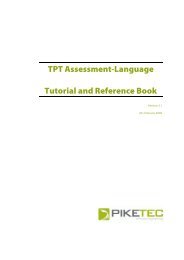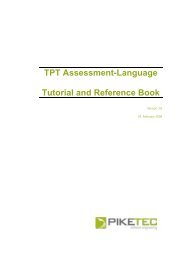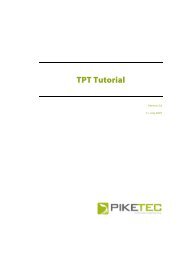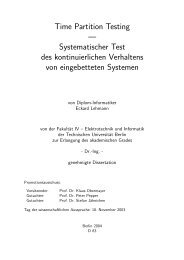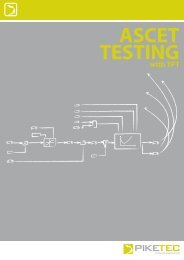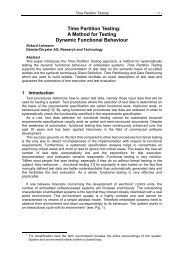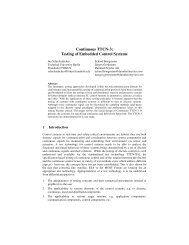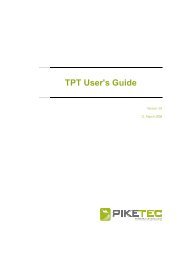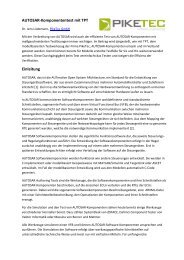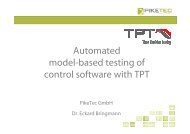TPT User's Guide - PikeTec
TPT User's Guide - PikeTec
TPT User's Guide - PikeTec
Create successful ePaper yourself
Turn your PDF publications into a flip-book with our unique Google optimized e-Paper software.
Page 74 <strong>TPT</strong> User’s <strong>Guide</strong><br />
This method is called capture & replay and, besides providing independence of the target<br />
environment, provides an additional advantage: a test run may be “debugged” repeatedly on<br />
the basis of a single test execution. This can save a lot of time.<br />
As in conventional programming languages it is possible to use a breakpoint in <strong>TPT</strong> to<br />
interrupt a test driver in its execution after reaching an internal state of the automaton specified<br />
by the user. Breakpoints may be added or deleted during the runtime of a debug session.<br />
As soon as the breakpoint has been reached all currently active states of the automaton are<br />
displayed. This also applies to all automatons that are used within the currently debugged test<br />
scenario. Thus, following conventional programming environments, all elements starting from<br />
an active state and describing a path through the automaton hierarchy up to its root can be<br />
understood as a stack-trace.<br />
To continue stepping through the interrupted test execution the user may<br />
• Resume the execution for one discrete step in time (step cycle).<br />
• Resume the execution until the next state transition (step over).<br />
• Unconditionally resume the test execution (resume).<br />
The execution of a <strong>TPT</strong> automaton may be stopped by the user at any time.<br />
14.2 Debug plug-in features<br />
The debug plug-in complements the application by supplying additional functionality needed<br />
for debugging. These extensions can roughly be divided into two sections: extensions to the<br />
user interface for modelling automatons or test cases and extensions to the test execution<br />
process to facilitate debugging of the execution.<br />
14.2.1 Extensions to the user interface: definition of breakpoints<br />
The set-up and the semantics of breakpoints are defined as follows:<br />
• A breakpoint must be defined within the context of an automaton. This may be the<br />
root testlet.<br />
• A breakpoint must be defined within the context of a scenario or a scenario group. If<br />
no scenario has been selected the default group of “all scenarios” will be used.<br />
• A breakpoint which is defined at the scenario group level applies to all scenarios and<br />
scenario groups contained therein. This mechanism is called inheritance or<br />
propagation of the breakpoint.<br />
• A trigger is the event which activates a breakpoint. There are trigger variants “on<br />
entry” and “on event”. The trigger variant “on entry” lets the breakpoint become active<br />
every time the execution of the test reaches the set state. In the trigger variant “on<br />
event” a condition also has to be logical “true”. The condition has to be stated in the<br />
“event” column and follow the syntax of <strong>TPT</strong>.



